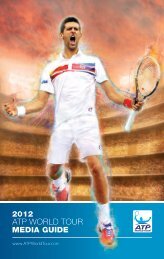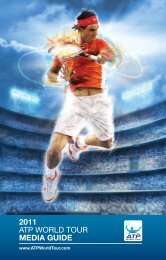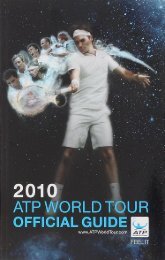- Page 1 and 2: the Tennis Drill Book SECOND EDITIO
- Page 3 and 4: This is for my husband, Alan, and m
- Page 5 and 6: PART III Competition and Match Play
- Page 7 and 8: Drill Title Level Forehand Backhand
- Page 9 and 10: Drill Title Level Chapter 9 Forehan
- Page 11 and 12: Drill Title Level chapter 13 Foreha
- Page 13: Drill Title Level Forehand Backhand
- Page 17 and 18: PART I Strokes and Techniques Since
- Page 19 and 20: Chapter 1 Grips
- Page 21 and 22: Lex Carrington Owner of Arthur Carr
- Page 23 and 24: 2. CONTINENTAL GRIP TECHNIQUE Objec
- Page 25 and 26: 4. WESTERN GRIP TECHNIQUE Objective
- Page 27 and 28: Chapter 2 Groundstrokes
- Page 29 and 30: 6. NEUTRAL-STANCE TECHNIQUE Objecti
- Page 31 and 32: 8. SEMI-OPEN STANCE TECHNIQUE Objec
- Page 33 and 34: 11. OPEN-STANCE TECHNIQUE Objective
- Page 35 and 36: 13. CROSSCOURT AND DOWN THE LINE Ob
- Page 37 and 38: 15. BASELINE RALLY Objective To lea
- Page 39 and 40: 17. BUGGY WHIP TECHNIQUE Objective
- Page 41 and 42: Chapter 3 Volleys
- Page 43 and 44: 19. SPLIT-STEP ATTACK Objective To
- Page 45 and 46: 22. HIGH-VOLLEY TECHNIQUE Objective
- Page 47 and 48: Bob and Mike: The Bryan Brothers Tw
- Page 49 and 50: 25. CRISSCROSS VOLLEY POACH Objecti
- Page 51 and 52: 27. OSCILLATION VOLLEY Objective To
- Page 53 and 54: 29. HALF-VOLLEY TECHNIQUE Objective
- Page 55 and 56: Chapter 4 Serves and Returns
- Page 57 and 58: 31. FLAT-SERVE TECHNIQUE Objective
- Page 59 and 60: 34. SERVICE BREATHING Objective To
- Page 61 and 62: 37. KNUCKLE BALL Objective To help
- Page 63 and 64: John Isner The Big Fella John Isner
- Page 65 and 66:
42. SLICE-SERVE TECHNIQUE Objective
- Page 67 and 68:
44. WALKING SERVE Objective To help
- Page 69 and 70:
46. KICK-SERVE TECHNIQUE Objective
- Page 71 and 72:
48. SQUAT LAUNCH SERVE TECHNIQUE Ob
- Page 73 and 74:
50. KICK SERVICE Objective To help
- Page 75 and 76:
52. SQUAT LAUNCH SERVICE Objective
- Page 77 and 78:
Chapter 5 Lobs and Overheads
- Page 79 and 80:
Chapter 5 Lobs and Overheads 63 bas
- Page 81 and 82:
56. OVERHEAD SMASH Objective To hel
- Page 83 and 84:
59. BACKHAND LOB TECHNIQUE Objectiv
- Page 85 and 86:
61. DROP AND LOB Objective To help
- Page 87:
63. LOB VOLLEY TECHNIQUE Objective
- Page 90 and 91:
74 The Tennis Drill Book All player
- Page 92 and 93:
76 The Tennis Drill Book Attack the
- Page 94 and 95:
78 The Tennis Drill Book • Passin
- Page 96 and 97:
65. BALL FEEDING Objective To help
- Page 98 and 99:
68. FAST SWING Objective To help pl
- Page 100 and 101:
69. MINICOURT Objective To help pla
- Page 102 and 103:
71. INSIDE-OUT FOREHAND Objective T
- Page 104 and 105:
88 The Tennis Drill Book Defensive
- Page 106 and 107:
74. SUNNY DAY Objective To learn ho
- Page 108 and 109:
76. CHOKE SYNDROME Objective To hel
- Page 110 and 111:
78. SINGLES AND DOUBLES OVERHEAD SM
- Page 112 and 113:
80. RECOVERY Objective To help play
- Page 114 and 115:
82. MAD MIXER Objective To teach pl
- Page 116 and 117:
84. SHOT TOLERANCE Objective To hel
- Page 118 and 119:
86. TEN-BALL SINGLES Objective This
- Page 120 and 121:
104 The Tennis Drill Book Developin
- Page 122 and 123:
88. STROKE HANDICAP Objective To he
- Page 124 and 125:
90. DOUBLE CUBE Objective To help m
- Page 126 and 127:
93. HACKER EQUALIZATION Objective T
- Page 128 and 129:
95. MASTER BASELINER EQUALIZATION O
- Page 130 and 131:
97. BASELINE COUNTERPUNCHER EQUALIZ
- Page 132 and 133:
116 The Tennis Drill Book Executing
- Page 134 and 135:
100. CROSSCOURT AND DOWN THE LINE O
- Page 136 and 137:
102. SINGLES CHALLENGE Objective To
- Page 138 and 139:
104. DEEP SHOT FOREHAND-BACKHAND Ob
- Page 140 and 141:
108. QUICK VOLLEY Objective To deve
- Page 142 and 143:
111. RISING STAR Objective To help
- Page 144 and 145:
115. ATTACK AND SMACK Objective To
- Page 146 and 147:
118. HIT (THE VOLLEYER) AND RUN Obj
- Page 148 and 149:
121. DOUBLES APPROACH LOB AND RECOV
- Page 150 and 151:
123. ATTACK AND DEFEND DOUBLES CHAL
- Page 152 and 153:
125. AUSTRALIAN DOUBLES Objective T
- Page 154 and 155:
127. QUICK VOLLEY, DROP OUT Objecti
- Page 157 and 158:
Chapter 10 Court Surface Tactics
- Page 159 and 160:
129. FIVE-BALL RECOVERY Objective T
- Page 161 and 162:
131. TRACTION AND BALANCE Objective
- Page 163 and 164:
133. FOUR-HIT SERVE-AND-VOLLEY Obje
- Page 165 and 166:
135. HURRICANE Objective To build s
- Page 167 and 168:
137. FAST GRASS Objective To help p
- Page 169 and 170:
139. HOT-PEPPER SINGLES Objective T
- Page 171:
142. TWO-ON-ONE SERVE-AND-VOLLEY Ob
- Page 174 and 175:
158 The Tennis Drill Book I have be
- Page 176 and 177:
144. TICK-TOCK Objective To use rhy
- Page 178 and 179:
146. TWO BACK-ONE UP Objective To t
- Page 180 and 181:
150. PREPLANNED SET Objective To he
- Page 182 and 183:
151. HARDCORE GROUNDSTROKE VOLLEY O
- Page 184 and 185:
153. ONE UP-ONE BACK Objective To d
- Page 186 and 187:
155. SERVE-AND-VOLLEY Objective To
- Page 189 and 190:
PART III Competition and Match Play
- Page 191 and 192:
Chapter 12 Singles Games
- Page 193 and 194:
159. KING OR QUEEN OF THE COURT Obj
- Page 195 and 196:
162. MINI-ME TENNIS Objective To he
- Page 197 and 198:
165. ROTATING SINGLES Objective To
- Page 199:
168. SINGLES GO Objective To help p
- Page 202 and 203:
186 The Tennis Drill Book Doubles i
- Page 204 and 205:
170. TENNIS BASEBALL Objective To r
- Page 206 and 207:
171. STICKY SITUATION Objective To
- Page 208 and 209:
174. STAYING ALIVE Objective To rei
- Page 210 and 211:
178. QUICK CHANGE Objective To use
- Page 212 and 213:
196 The Tennis Drill Book Tennis pl
- Page 214 and 215:
180. DOUBLES SERVING TEAM Objective
- Page 216 and 217:
182. ROTATING DOUBLES Objective To
- Page 218 and 219:
184. PASSING-SHOT MEDUSA Objective
- Page 220 and 221:
187. TEAM MERRY-GO-ROUND Objective
- Page 223 and 224:
PART IV Court Movement and Conditio
- Page 225 and 226:
Chapter 15 Endurance Training
- Page 227 and 228:
189. POINT AND GO Objective To teac
- Page 229 and 230:
192. STEP-OUT VOLLEY Objective To h
- Page 231 and 232:
194. DEXTERITY BALL Objective To te
- Page 233 and 234:
196. FAN Objective To help players
- Page 235 and 236:
198. COURT CIRCUIT Objective To imp
- Page 237:
200. SPIDER Objective To promote sh
- Page 240 and 241:
224 The Tennis Drill Book The purpo
- Page 242 and 243:
202. HAMSTRING STRETCH Objective To
- Page 244 and 245:
204. POSTERIOR SHOULDER STRETCH Obj
- Page 246 and 247:
207. TORSO ROTATION Objective To st
- Page 248 and 249:
210. SPEEDY INTERVAL TRAINING Objec
- Page 250 and 251:
213. SPINAL TWIST Objective To stre
- Page 252 and 253:
215. COMPOUND ROW Objective To deve
- Page 254 and 255:
219. LATERAL DELTOID RAISE Objectiv
- Page 257 and 258:
VPART Competitive Group Games Teach
- Page 259 and 260:
Chapter 17 Teaching Group Games
- Page 261 and 262:
222. BALL PICKUP Objective To creat
- Page 263 and 264:
226. POP-UP VOLLEY Objective To dev
- Page 265 and 266:
229. DUCK, DUCK, GOOSE Objective To
- Page 267 and 268:
232. MESSY CHEESEBURGER Objective T
- Page 269 and 270:
235. GO TO JAIL! Objective To encou
- Page 271 and 272:
238. RED LIGHT! GREEN LIGHT! Object
- Page 273 and 274:
240. FLY CATCHER Objective To devel
- Page 275 and 276:
242. BASKETBALL TENNIS Objective To
- Page 277 and 278:
244. LIZARDS HAVE TWO SKINS Objecti
- Page 279 and 280:
246. FREEZE-TAG TENNIS Objective To
- Page 281 and 282:
250. BACK-ALLEY RACKET KING Objecti
- Page 283 and 284:
Chapter 18 Backboard Drills
- Page 285 and 286:
253. BULLSEYE BACKBOARD Objective T
- Page 287 and 288:
257. PLUS OR MINUS Objective To hel
- Page 289 and 290:
260. RACK ATTACK Objective To encou
- Page 291 and 292:
Glossary This is a tennis glossary.
- Page 293 and 294:
Glossary 277 floater—A ball that
- Page 295 and 296:
Glossary 279 service line—The lin

















